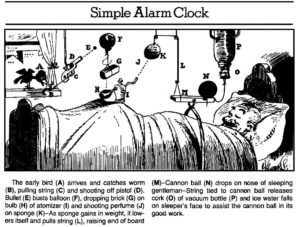Profile
Dan Watson
Curriculum Vitae
-
Work History:
Freelance design engineer (helping robots dance with ballerinas among other things), started SafetyNet Technologies (to try and help save fish), joined Satellite Applications Catapult
-
Current Job:
Lead Designer
-
Employer:
Satellite Applications Catapult
-
My Work
I try to figure out what problems need solving and why, then design solutions for them which might be products, services or experiences.
-
Read more
I run the Design Team at the Satellite Applications Catapult. Design, you say? But that’s not engineering!
Actually the design work we do at the Catapult is more focused on understanding what different people need to solve problems they’re facing, so that we and our colleagues can make the best use of the time and resources we have available to make the biggest impact on the problem. I’ve heard it described nicely in the following way,
“The designer isn’t the source of the answer, but the source of the question.”
However, in the Catapult we also work with other teams in a multi-disciplinary way to provide solutions that take everyone into account, from the manufacturers who make it to the government that says how it can be used to the end-users who directly benefit from it so that they are all satisfied. The goal is to make sustainable solutions, which means that they will solve problems for a long time.
-
My Typical Day: Lots of varied projects, lots of people with different skills – how do we get them to work together for the best outcome?
-
Read more
The design team all have technical backgrounds as well as their formal training in design thinking. One part of being a designer is helping people with very different skills and approaches to work together to solve problems. This can lead to much better solutions as all areas of development are considered during the design process.
Do you need to understand how some science works? Designers will find a scientist to talk to. How this service can fit within a particular law? We’ll find a lawyer to ask. Better than all this, let’s see if we can get people in the same room and working together at the same time so we can answer these questions as they come up.
Then we make prototypes, quick-to-make models or experiments which can be built in many formats (digital, physical, etc), to test the ideas with users and see which ones work. We can then use these to guide the next version of the design and test it again.
-
What I'd do with the money
The world’s best Rube-Goldberg machine made from Arduinos to be exhibited somewhere awesome.
-
Read more
Learning through making is a big part of what we do at the Satellite Applications Catapult. It’s a great way of testing how mechanisms work, whether physics will help or hinder your idea, if it does what it was designed to do, etc… Being able to control simple mechanisms, with devices that can sense and respond to changes and make their own changes is really useful, and so we sometimes use computer programming to do this. One thing we use is called a microcontroller board, and a good example of this is an Arduino.
A Rube-Goldberg machine is a device that performs a set of consecutive actions and used to work only through use of Newton’s First Law, which states, “every object will remain at rest or in uniform motion in a straight line unless compelled to change its state by the action of an external force.” An example is the game, Mousetrap. However, now that we have powered devices and computer control, we can make far crazier machines that use mechanisms to do all sorts of things. My proposal is to buy some Arduinos and learn to use them to hack together lots of individual mechanisms (designed and built by different schools/individuals) and then combine them to make an awesome Rube-Goldberg machine! This will teach people about inputs and outputs and how the digital world can control elements of the physical world – plus hardware hacking!
-
My Interview
-
How would you describe yourself in 3 words?
Fascinated Observant Experimental
What's the best thing you've done in your career?
Helped make a huge robot dance on-stage at the Royal Opera House in London, with some of the world’s best dancers (and it worked!)
What did you want to be after you left school?
A design engineer!
Were you ever in trouble at school?
Yes, but for all the right reasons.
If you weren't doing this job, what would you choose instead?
Bored (but probably an explorer)
Who is your favourite singer or band?
The Cat Empire
What's your favourite food?
Lebanese food is awesome
What is the most fun thing you've done?
Travelled and seen the world.
Tell us a joke.
There are 10 types of people in the world. Those who understand binary notation, and those who don’t.
-

